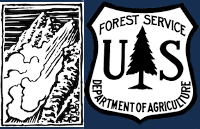GNFAC Avalanche Forecast for Sat Apr 5, 2025
<p><span><span><span><span><span><span>Wet snow is back to the top of our list of concerns. Most sunny slopes will have a thin crust at the surface this morning that will break down as the day heats up. As the crust melts and the softer snow underneath gets wet, expect to see and trigger </span></span></span></span></span></span><span><span><span><strong><span><span>Wet Loose avalanches</span></span></strong></span></span></span><span><span><span><span><span><span>. These slides could break at your feet, or come down from rocky areas above you. Do not discount the danger of these slides. With plenty of soft snow from the last week, these wet loose avalanches could get pretty big. With firm crusts underneath the recent snow, they will also run long distances. Look for a wet snow surface and roller balls rolling down the hill as your indications that it’s time to get off steep, sunny slopes. The peak instability will be late this afternoon, after slopes have baked for hours in intense April sunshine.</span></span></span></span></span></span></p>
<p><span><span><span><span><span><span>You might also still be able to find an isolated </span></span></span></span></span></span><span><span><span><strong><span><span>wind slab</span></span></strong></span></span></span><span><span><span><span><span><span> that could still avalanche. Most of these will be well bonded at this point, but do be on the lookout for unstable drifts on high elevation shady slopes, particularly those above cliffs or rocks where even a small slide would have big consequences. </span></span></span></span></span></span></p>
<p><span><span><span><span><span><span>The avalanche danger will start off LOW this morning and quickly rise to MODERATE as the day heats up and it becomes possible to trigger large avalanches.</span></span></span></span></span></span></p>
Wind Slab Avalanche Near Cooke
Wind slab near Cooke City from yesterday. Intentionally triggered. North aspect, 10,100'. 1' deep, 20' wide. Photo: B Fredlund
Forecast link: GNFAC Avalanche Forecast for Sat Apr 5, 2025
GNFAC Avalanche Forecast for Fri Apr 4, 2025
<p><span><span><span><span><span><span>Today’s transition between colder, snowy weather and warm, sunny, springlike weather bring a range of concerns.</span></span></span></span></span></span></p>
<p><span><span><span><span><span><span>While winds have generally been light, </span></span></span></span></span></span><span><span><span><strong><span><span>Wind Slab avalanches</span></span></strong></span></span></span><span><span><span><span><span><span> are a concern in places where winds have drifted and slightly stiffened the recent snow. Look for these drifts below cornices and near ridgelines. With east winds in the Bridger Range, there may be drifts in some unusual locations, so be particularly watchful there. Over the last couple days, thin, relatively small, wind slabs have been reported in the </span></span></span></span></span></span><a href="https://www.mtavalanche.com/node/34832"><span><span><span><span><span><… Range</span></span></u></span></span></span></span></span></a><span><span><span><span><span><span>, </span></span></span></span></span></span><a href="https://www.mtavalanche.com/node/34824"><span><span><span><span><span><… Basin</span></span></u></span></span></span></span></span></a><span><span><span><span><span><span>, and the </span></span></span></span></span></span><a href="https://www.mtavalanche.com/node/34826"><span><span><span><span><span><… around Cooke City</span></span></u></span></span></span></span></span></a><span><span><span><span><span><span>. Looking for wind textured surfaces and avoiding drifts is the easiest way to deal with this problem. </span></span></span></span></span></span></p>
<p><span><span><span><strong><span><span>Dry loose avalanches </span></span></strong></span></span></span><span><span><span><span><span><span>(sluffs) can pack a surprising punch and there is plenty of soft snow for them to entrain. Don’t underestimate their power if you’re getting onto steeper slopes. </span></span></span></span></span></span></p>
<p><span><span><span><span><span><span>As soon as direct sunshine hits slopes today </span></span></span></span></span></span><span><span><span><strong><span><span>wet loose avalanches </span></span></strong></span></span></span><span><span><span><span><span><span>will become the big player. Today will be the first time the recent snow gets wet. This initial wetting is often the peak of instability for wet loose avalanches. With lots of recent snow, these could be quite big slides and they’ll run a long way on last week’s crusts.</span></span></span></span></span></span></p>
<p><span><span><span><span><span><span>Temperatures are warmer and it’s going to be sunnier around West Yellowstone, Island Park, and Cooke City this morning, so the onset of these wet loose slides will be earlier in those places. Near Bozeman and Big Sky, there is more new snow but temperatures are cooler and clouds should stick around for longer, so it’ll take longer for things to get going, but once they do, we could see bigger avalanches.</span></span></span></span></span></span></p>
<p><span><span><span><span><span><span>Be on alert as soon as the sun is not blocked by clouds. The snow surface getting sticky and wet and rollerballs rolling down hill are your clues that it’s time to move to shadier or less steep slopes. </span></span></span></span></span></span></p>
<p><span><span><span><span><span><span>With a range of concerns to watch for and large avalanches possible, the avalanche danger is MODERATE today.</span></span></span></span></span></span></p>
<p> </p>
Stable Snow on Ellis
My ski partner and I toured up Ellis today and skied the typical east facing gullies.
We found the new snow to be bonding well to the crust and no significant instabilities within the new snow. Light snowfall off and on throughout the day, total accumulation no more than 0.5in, sky broken to obscured. Excellent skiing above 7K
A Pair of Small Avalanches on Saddle Peak
I was skiing in bounds on Slushman’s lift and saw a pair of R1, D1 avalanches on Saddle Peak. One appears to be a loose snow avalanche triggered by a skier coming off of north Saddle Peak That ran a couple hundred feet. The second was a small slab coming out of Spencer’s with debris running into Going Home Chute.
There were many tracks across the visible Saddle Peak terrain.
There was a pair of R1, D1 avalanches on Saddle Peak. One appears to be a loose snow avalanche triggered by a skier coming off of north Saddle Peak That ran a couple hundred feet. The second was a small slab coming out of Spencer’s with debris running into Going Home Chute. Photo: GNFAC
Forecast link: GNFAC Avalanche Forecast for Fri Apr 4, 2025
